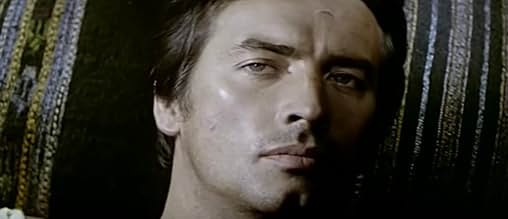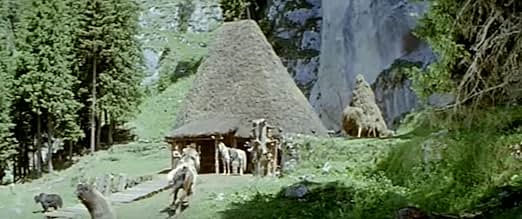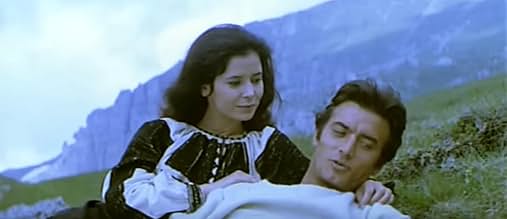IMDb रेटिंग
7.6/10
2.1 हज़ार
आपकी रेटिंग
अपनी भाषा में प्लॉट जोड़ेंThe Dacian kingdom lies at the eastern border of the Roman Empire.Only the river Danube separates the two mortal enemies.The Dacian king Decebalus knows that soon the vastly superior Roman l... सभी पढ़ेंThe Dacian kingdom lies at the eastern border of the Roman Empire.Only the river Danube separates the two mortal enemies.The Dacian king Decebalus knows that soon the vastly superior Roman legions will cross the river and attack Dacia.The Dacian kingdom lies at the eastern border of the Roman Empire.Only the river Danube separates the two mortal enemies.The Dacian king Decebalus knows that soon the vastly superior Roman legions will cross the river and attack Dacia.
- निर्देशक
- लेखक
- स्टार
फ़ीचर्ड समीक्षाएं
surprising is a strange word for define it.but it is the reasonable one. because, it is part of a political context and it has the art to escape from it. because it gives a clear and almost touching picture of life style, laws and roots of a lost word with admirable historical accuracy. because it has the right actors and the performance of Amza Pellea is real admirable. a film about a clash, between an empire and a kingdom . and the levels of a civilization who escapes from idyllic formulas. "Dacii" remains surprising because it crashes the expectations. it is not exactly a propaganda tool and it is not a demonstration of party vision. maybe, it could be perceived as a good history lesson. in fact, a film about a land and his people.
Attractive Romanian film (actually a Romanian-French co production filmed in Romania) belonging to the swords and sandals genre and telling the story of how the Dacians confronted and resisted the Roman Empire at around 100 AD. Great action scenes, attractive outdoor locations (in pastoral like locations) are a plus. This was made in 1967, when many films of this sort were made in the West (the so called Peplum, including Spartacus, Cleopatra and countless Italian movies), yet this particular film seems to be little known outside Romania. It is a well made, entertaining film with fine color photography. Since the Dacians are believed to be the ancestors of the Romanians, I suppose part of the purpose of the film was to raise nationalist consciousness, but this is thankfully not too heavy.
I wish people were less "detached" and less bored sometimes, to appreciate valuable movies for what they really are - valuable movies. As I am about to finish watching "Columna" on TV here in Bucharest, I'm thinking how lucky we are to have this fascinating history. To us, both "Dacii" and "Columna" are excellent and make very valid points as to how ancient Dacia was conquered by the Romans.
I am sorry that these movies (as many other Romanian historical movies) are not easy to find in the West, as the viewer comments on here seem to indicate. (I'd initially come on here to see where they could be found, to recommend them to a friend in the West). I think they would also prove useful, providing a wealth of information and "insight" for anyone wanting to learn more about this part of the world.
I am sorry that these movies (as many other Romanian historical movies) are not easy to find in the West, as the viewer comments on here seem to indicate. (I'd initially come on here to see where they could be found, to recommend them to a friend in the West). I think they would also prove useful, providing a wealth of information and "insight" for anyone wanting to learn more about this part of the world.
10vic441
Unlike many Hollywood movies of the same period (Cleopatra, Ben-Hur, Fall of the Roman Empire, etc) this one is almost perfect in the historical accuracy sence. They used the latest archeological data available at the time (Trajan's column) to show Roman legions in their glory. Cinematography is great. I've heard they used something like 5,000 extras to create battle scenes. Unlike its sequel (Collona), this movie is a masterpiece for everyone who likes cinema and ancient history. I think that if it would be released in the USA it would be nominated for Oscar. Its a shame that this video is hard to find and is not available in major stores.
A Romanian film – better-known, if at all, by its original title DACII – about the Roman (i.e. Italian) Empire is an absolute rarity, but I was instantly drawn to it from the evocative stills I saw on the Internet. The fact that it featured a couple of French stars in Pierre (MILL OF THE STONE WOMEN {1960}) Brice and Luis Bunuel/peplum regular Georges Marchal, then, was merely the icing on the cake; however, it did feel odd hearing them speak in a completely foreign tongue! For all its obvious naivete' (being, at best, a semi-professional enterprise and actually only the director's first feature-length effort!), the end result proves reasonably impressive – primarily on the visual front (with location photography that is indeed spectacular and the battle sequences themselves emerging as not only surprisingly elaborate but rather brutal as well!).
That said, the plot offers its own interest – with even some novelty value in store: the titular people are engaged in war against the Romans (rulers of all the known world at that time). Being Pagans, to determine whether the odds are in their favor or not, it is required that the King sacrifice his first-born i.e. a son who is literally dumped upon an upturned fork and bleeding to death! This turn-of-events naturally sours the relationship between the potentate and his daughter, who leaves the castle grounds to settle in the country. The Romans, too, have their problems: Emperor Domitien is perhaps the most condescending ever portrayed; his adviser is adamantly against invasion (believing the Dacians can be persuaded to lay down their arms without the need for carnage); their ageing if still athletic champion warrior (Marchal) is suffering from temporary blindness due to an old wound; while another 'star' officer (Brice, actually the afore-mentioned bureaucrat's son) is wounded during an initial skirmish, cured for by the Dacian king's daughter (needless to say, they end up falling in love), and ultimately revealed to be a native of the very land he is intent on conquering for the glory of Rome!
A sort of follow-up, made by other hands, was 1968's COLUMNA aka THE COLUMN which similarly featured 'recognizable' names for the international market (though their overseas exposure was extremely limited in the long run!): Briton Richard Johnson and Italians Antonella Lualdi (from Vittorio Cottafavi's THE HUNDRED HORSEMEN {1964}) and Franco Interlenghi. Actually, THE DACIANS reminded me of Robert Siodmak's two-parter STRUGGLE FOR ROME (1968) – a German epic that was only released abroad in heavily-truncated form as THE LAST ROMAN.
That said, the plot offers its own interest – with even some novelty value in store: the titular people are engaged in war against the Romans (rulers of all the known world at that time). Being Pagans, to determine whether the odds are in their favor or not, it is required that the King sacrifice his first-born i.e. a son who is literally dumped upon an upturned fork and bleeding to death! This turn-of-events naturally sours the relationship between the potentate and his daughter, who leaves the castle grounds to settle in the country. The Romans, too, have their problems: Emperor Domitien is perhaps the most condescending ever portrayed; his adviser is adamantly against invasion (believing the Dacians can be persuaded to lay down their arms without the need for carnage); their ageing if still athletic champion warrior (Marchal) is suffering from temporary blindness due to an old wound; while another 'star' officer (Brice, actually the afore-mentioned bureaucrat's son) is wounded during an initial skirmish, cured for by the Dacian king's daughter (needless to say, they end up falling in love), and ultimately revealed to be a native of the very land he is intent on conquering for the glory of Rome!
A sort of follow-up, made by other hands, was 1968's COLUMNA aka THE COLUMN which similarly featured 'recognizable' names for the international market (though their overseas exposure was extremely limited in the long run!): Briton Richard Johnson and Italians Antonella Lualdi (from Vittorio Cottafavi's THE HUNDRED HORSEMEN {1964}) and Franco Interlenghi. Actually, THE DACIANS reminded me of Robert Siodmak's two-parter STRUGGLE FOR ROME (1968) – a German epic that was only released abroad in heavily-truncated form as THE LAST ROMAN.
क्या आपको पता है
- ट्रिवियाThe Dacian costumes were hard to create. Director Sergiu Nicolaescu had to travel to Rome where he studied the Dacian costumes featured on Trajan's Column. The costumes were created by Romanian costume designer Hortensia Georgescu.
- गूफ़In some scenes, watches are visible on the wrists of Roman and Dacian soldiers.
- कनेक्शनReferenced in German Grusel - Die Edgar Wallace-Serie (2011)
टॉप पसंद
रेटिंग देने के लिए साइन-इन करें और वैयक्तिकृत सुझावों के लिए वॉचलिस्ट करें
- How long is The Dacians?Alexa द्वारा संचालित
विवरण
बॉक्स ऑफ़िस
- बजट
- ROL 2,01,13,000(अनुमानित)
- चलने की अवधि
- 1 घं 50 मि(110 min)
- ध्वनि मिश्रण
- पक्ष अनुपात
- 2.35 : 1
इस पेज में योगदान दें
किसी बदलाव का सुझाव दें या अनुपलब्ध कॉन्टेंट जोड़ें





















